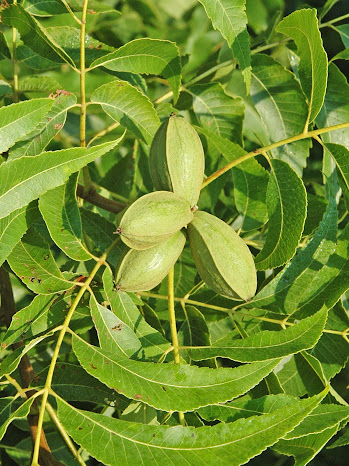During the last week of June and the first couple of weeks of July, I try to visit every successful graft I made this year. Pictured at right is a 3-flap graft made with a Kanza scion. The scion has made good growth but the rootstock below the graft has also sprouted several vigorously growing shoots. During this time of year, I like to prune off all rootstock sprouts and trim the scion down to a single shoot.
Just by removing the rootstock sprouts, this graft looks to have made a good start towards growing into a strong central leader tree (photo at left). However, there remains a few more details that need attention.
Earlier this Spring, the new shoot that sprouted from the scion terminated in a pistillate flower cluster (photo above left). The development of a flower cluster temporarily slowed the grow of the shoot but the terminal vegetative bud adjacent to the flower cluster eventually broke and started to grow. To promote the growth of that vegetative shoot, I pruned off the flower cluster (photo above right).
In trimming the scion down to a single shoot, I made two additional cuts. The first was to remove a shoot developing from the secondary bud just below the main new shoot. And the second was to remove the stub above the new shot. By making an angled cut, I will encourage the rapid healing over of the cut at the top of the scion.
To prevent the graft from becoming girdled by the grafting tape used to make a 3-flap graft, I remove all wraps from the graft at this time of year. Once the tape is removed you can easily see the flaps tightly attached to the scion (photo at right). You will also note white callus tissue growing in the cracks between the flaps. Also notice how this callus tissues causes the graft union to swell especially near the base of the graft. This is normal for 3-flap grafts. In a few years, the swelling at the graft union will disappear.
Rapidly growing callus tissue is very susceptible to sunburn and requires protection. To block the sun, I re-wrap the graft union with aluminum foil and tie it on with grafting tape (photo at left). The grafting tape is tied just tight enough to hold foil in place so it can't be blown away by the wind.
The final step in mid-summer graft care is to tie the new scion shoot to my tree training stake (photo at right). I use flagging tape to gently hold the shoot in place. Tying the scion will prevent shoot breakage that can occur during strong summer storms. The wire cage seen in the background of this photo will be placed over this young tree to prevent deer damage.











